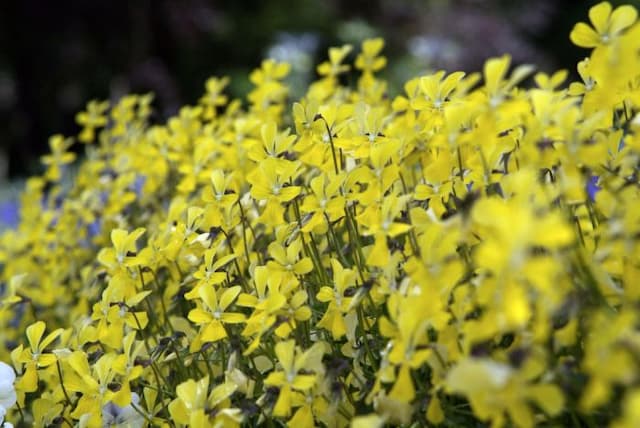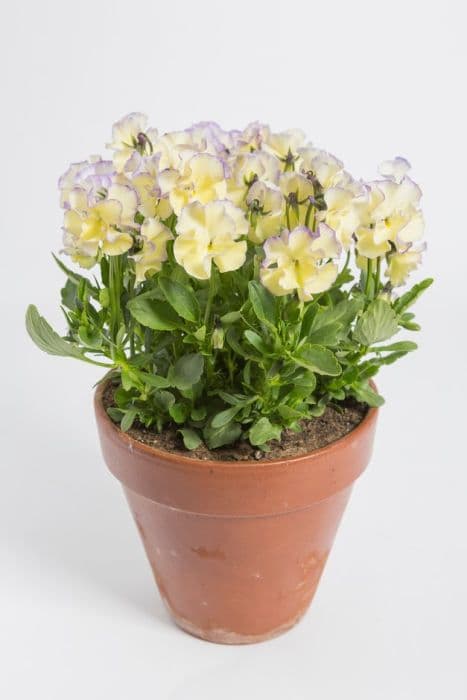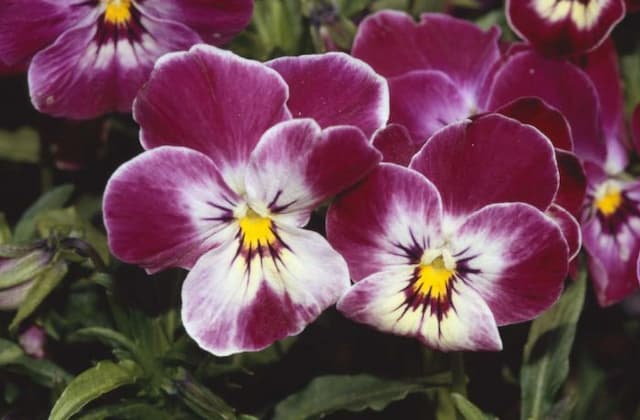Pansy Viola 'Aspasia' (Va)

ABOUT
Viola 'Aspasia' is a lovely and enchanting plant that features a unique blend of colors and forms. Its foliage consists of lush green leaves that serve as a rich backdrop to its standout feature: the delicate flowers. The blooms of the Viola 'Aspasia' are often a compelling mix of purples and yellows, with petals that can exhibit a variety of patterns including solid colors, streaks, or even charming face-like center patterns that are typical in pansies, which is the common name for some members of the Viola genus. The texture of the petals is velvety and they come together in a classic pansy shape, with five rounded petals that are slightly overlapping. Two petals usually extend upwards, while the other three fan out below. The flowers offer not only a visual treat but also frequently deliver a gentle and sweet fragrance that adds an additional layer of enjoyment to the presence of this plant. The blooms of the Viola 'Aspasia' are generously produced and can typically be seen in the cooler months, adding a cheerful note to gardens when many other plants are not in flower.
About this plant
 Names
NamesFamily
Violaceae.
Synonyms
Garden Pansy, Aspasia Pansy.
Common names
Viola 'Aspasia'.
 Toxicity
ToxicityTo humans
The plant commonly known as violet, including the Viola 'Aspasia', is generally not considered toxic to humans. Violets are often used in culinary applications, and their flowers can be consumed in moderation. However, the excessive consumption of any plant material can lead to gastrointestinal distress or allergic reactions in some individuals. If large amounts are ingested, one might experience symptoms such as nausea, vomiting, diarrhea, or abdominal pain. It's always wise to exercise caution and avoid eating plants unless you are certain they are safe for consumption and you do not have specific sensitivities.
To pets
Violets, including the Viola 'Aspasia', are generally not considered toxic to pets. They are often seen as safe for dogs, cats, and other domestic animals. If a pet were to ingest a small amount of this plant, it is unlikely to cause any significant symptoms of poisoning. However, just like in humans, consumption of plant material in large quantities could potentially lead to gastrointestinal upset in some pets, such as vomiting or diarrhea. Always monitor your pets around plants and consult with a veterinarian if any concerning symptoms arise after ingestion.
 Characteristics
CharacteristicsLife cycle
Perennials
Foliage type
Evergreen
Color of leaves
Green
Flower color
Mixed
Height
0.5 feet (15 cm)
Spread
0.5 feet (15 cm)
Plant type
Herb
Hardiness zones
Varies
Native area
Europe
Benefits
 General Benefits
General Benefits- Aesthetic Appeal: The Viola 'Aspasia', commonly known as a type of violet, offers beautiful blooms that enhance garden aesthetics.
- Easy to Grow: Violets are known for being easy to tend to, making them suitable for beginner gardeners.
- Long Blooming Season: They have a prolonged blooming period, providing color in the garden for an extended time.
- Attracts Pollinators: Violets can attract bees and butterflies, which are beneficial for pollinating other plants in the garden.
- Ground Cover: Low-growing varieties can serve as a ground cover to reduce soil erosion and suppress weeds.
- Edible Parts: Some parts of violets are edible, and they can be used to add a decorative touch to salads and desserts.
- Hardiness: Violets are generally hardy and can survive in a variety of climates and conditions.
 Medical Properties
Medical PropertiesThis plant is not used for medical purposes.
 Air-purifying Qualities
Air-purifying QualitiesThis plant is not specifically known for air purifying qualities.
 Other Uses
Other Uses- Edible Decoration - The flowers of the pansy can be used to add a splash of color and a mild, fresh flavor to salads or as an edible garnish on desserts and dishes.
- Natural Dye - The petals can be used to create a natural dye for fabric, yarn, or even Easter eggs, producing a range of colors from yellow to green depending on the mordant used.
- Garden Art - Pressed pansy flowers can be used in art projects, such as creating botanical prints or decorative bookmarks.
- Ice Cubes - Frozen pansy flowers in ice cubes make a distinctive and attractive addition to punches and cocktails for special occasions.
- Perfumery - While not common, pansy flowers can sometimes be used in the production of mild, sweet perfumes.
- Flower Arranging - Pansies can be included in small floral arrangements or posies to provide a touch of whimsy and color.
- Crafting - Dried pansy flowers can be incorporated into homemade soaps, candles, and potpourri mixes to add fragrance and visual appeal.
- Photography - The vibrant flowers serve as excellent subjects for macro photography, highlighting the intricate patterns and colors of the petals.
- Education - Pansies can be used in educational settings to teach about plant biology, pollination, and the life cycle of flowers.
- Environmental Indicator - The presence and health of pansy plants in the wild can serve as an indicator of local environmental conditions, such as soil quality and the presence of pollinators.
Interesting Facts
 Feng Shui
Feng ShuiThe pansy is not used in Feng Shui practice.
 Zodiac Sign Compitability
Zodiac Sign CompitabilityThe pansy is not used in astrology practice.
 Plant Symbolism
Plant Symbolism- Innocence: Violets, including the cultivar 'Aspasia', often symbolize innocence due to their delicate and unassuming appearance.
- Modesty: Violets have been historically related to modesty because they are small and often found hiding among their foliage.
- Faithfulness: The plant's habit of returning each year with bright blossoms has made it emblematic of constancy and fidelity.
- Humility: Because they grow close to the ground and do not tower over other plants, violets represent humility.
- Spiritual Wisdom: The deep purple color of some violet flowers, including Viola 'Aspasia', can signify the pursuit of knowledge and spiritual realization.
- Mourning: Violets are sometimes associated with mourning and remembrance, possibly due to their subdued and unobtrusive nature.
 Water
WaterThe common pansy, specifically Viola 'Aspasia', requires consistent moisture and should be watered when the soil surface feels dry to the touch. Aim to water this plant about once a week, but adjust according to weather conditions, increasing watering during hot, dry periods and reducing during cooler, wetter times. Use a gentle watering method to avoid disturbing the soil or damaging the flowers; a watering can with a diffuser is ideal. Each watering session should provide enough water to moisten the soil to a depth of about 6 inches, which could be approximately 1 gallon for a standard outdoor garden setting; pots may need less depending on their size.
 Light
LightPansies, including Viola 'Aspasia', thrive best in full sun to partial shade conditions. They prefer a spot that gets at least 6 hours of sunlight per day, but they also benefit from some afternoon shade in regions with very intense midday sun. Ensure they are planted in a location that offers bright, indirect light for the majority of the day for optimal growth and flower production.
 Temperature
TemperaturePansies like Viola 'Aspasia' are best suited to cooler temperatures and can generally tolerate temperatures as low as 25°F and as high as 75°F. They perform ideally when daytime temperatures are between 40°F and 60°F, and they might start to struggle when temperatures exceed 80°F. Prolonged heat can cause pansies to become leggy and decrease flower production.
 Pruning
PruningFor pansies, including Viola 'Aspasia', pruning is essential to promote vigorous growth and prolong the blooming period. Deadheading, or the removal of spent flowers, should be done regularly to encourage more blooms. Additionally, lightly pruning any leggy growth can help maintain a compact and attractive shape. The best time to prune pansies is in the early morning or late evening to avoid stressing the plants in the heat of the day.
 Cleaning
CleaningAs needed
 Soil
SoilPansies like well-draining, rich soil with a pH of 6.0 to 6.5. For the best soil mix, combine equal parts garden soil, peat moss, and perlite or sand to ensure good drainage and fertility.
 Repotting
RepottingPansies typically do not require frequent repotting and can be repotted every 1-2 years or if they outgrow their current container.
 Humidity & Misting
Humidity & MistingPansies prefer average humidity levels and do not require excessively high humidity; they are adaptable to outdoor conditions.
 Suitable locations
Suitable locationsIndoor
Place in bright, indirect light and keep soil moist.
Outdoor
Plant in partial shade, shelter from harsh sun.
Hardiness zone
4-8 USDA
 Life cycle
Life cycleViola 'Aspasia', commonly known as 'Aspasia' viola, begins its life as a seed, often requiring a period of cold stratification to break dormancy and germinate. Upon germination, it develops into a seedling with characteristic heart-shaped leaves and a developing root system. As a juvenile plant, it continues to gather sunlight for photosynthesis, growing larger leaves and establishing a stronger root network. The vegetative stage is marked by the development of flowering stems, and it transitions to the flowering stage where it produces distinctive flowers that can be purple, blue, or white, often with a pleasant fragrance. Following pollination, typically by insects, 'Aspasia' violas produce seed capsules that, when mature, dehisce to release seeds, thereby completing the reproductive cycle. Given the right conditions, Viola 'Aspasia' can live for several years, forming clumps and spreading through both seed and vegetative means.
 Propogation
PropogationPropogation time
Spring-Early Summer
For Viola 'Aspasia', commonly known as the Sweet Violet, the most popular method of propagation is division. This involves separating the plant into smaller sections, each with its own root system. Division is typically done in the spring or fall. To propagate through division, carefully lift the plant from the ground and gently pull apart the clumps of crowns, ensuring that each new section has a portion of the roots attached. The divisions can then be replanted directly into the garden, spaced about 6 to 12 inches apart (15 to 30 centimeters), or potted in containers with well-draining soil. Water the new plantings thoroughly to help establish them. This method allows the gardener to quickly increase the number of Sweet Violet plants while maintaining the characteristics of the 'Aspasia' cultivar.









